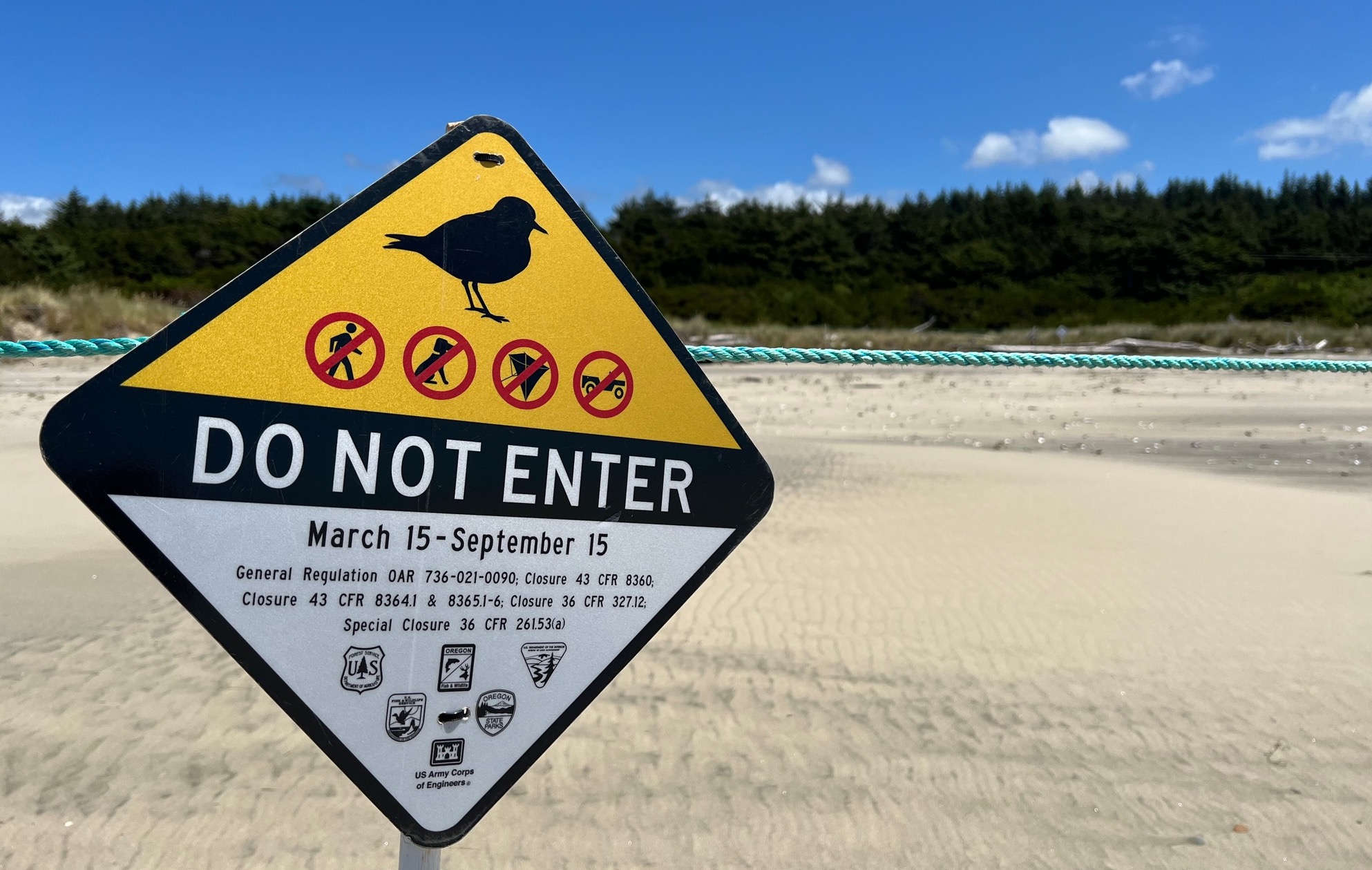
By DANA TIMS/YachatsNews
Lincoln County’s narrow beaches can make life difficult for western snowy plovers, those diminutive, long-endangered birds that nest in small crevices along the sand.
Take last year, for instance.
Volunteers counted a total of 29 nests scattered between Newport and Yachats. After torrential rains hit in June, during peak nesting season, only five surviving nests produced a total of seven birds.
“We took a step backward last year,” said Roy Lowe, a retired wildlife biologist from Waldport who leads a small army of plover-spotting volunteers. “Plovers did really poorly here.”
This year, however, there appears to be something of a rebound underway. The 43 nesting attempts charted so far along the central coast is second only to the 48 nests tallied in 2021.
“The birds are doing better than expected and their population is expanding,” Lowe said. “Everything we’re seeing so far amounts to a good-news story.”
Jodie Delavan, a U.S. Fish and Wildlife Service spokesperson, agreed. She said efforts to survey and assess the birds over a long period is helping wildlife stewards with the overall goal of restoring plovers to traditional areas they have long been pushed out of.
“Long-term monitoring of plovers in Oregon shows our population is doing well and expanding to reclaim its former nesting range,” Delavan said. “The fact that our population remains well and above recovery goals really speaks to the amazing partnerships we have here.”
The numbers of nests and chicks all along the coast are also up this year, said Cheryl Strong, a U.S. Fish and Wildlife Service biologist in Newport.
A total of 113 nests have been found and monitored by volunteers, with the bulk of those in Lincoln County and to the north, she said. At least 30 chicks have fledged from those nests. Some of these nests are in areas managed for snowy plovers, she added, while others are in open beach areas, including the ones spotted in Lincoln County.
In the traditional nesting area for plovers, which extends from Florence to Bandon, a total of 546 nests have been found and monitored by plover biologists, Strong said. While information on fledglings from these sites hasn’t yet been tallied, the overall nest success appears to be “low-to-average” at about 22 percent.
Overall, Strong said, “The population remains well above our recovery goal of 200 plovers in Oregon.”
Getting message out

Lowe and his volunteer assistants spend hours each week, often with binoculars in hand and lying flat on the sand, searching for signs of new nests. In the event they find one, they notify Oregon Parks Department beach rangers – Doug Sestrich to the south and Ryan Parker to the north — who then move in to place ropes designed to keep beachcombers and their dogs from disturbing the area.
This practice has been going on since the late 1990s, when snowy plovers were first listed under the federal Endangered Species Act. Then, as now, intentionally disturbing plover nesting sites is illegal and can result in substantial penalties.
The effort to protect plovers was controversial, especially when it was first rolled out, Lowe said.
In the intervening years, much of that controversy abated. Today, only about 12 percent of Oregon beaches are closed for plovers, with the bulk of those in Lane, Douglas and Coos counties.
Specific management plans are in place in those three counties to try to ensure that a total statewide plover population that dropped to only about 50 birds in the 1990s is protected going forward.
There are no closed beaches in Lincoln County and here, as elsewhere, wet-sand areas are always open to the public.

A plover primer
Western snowy plovers, which move along the sand by foot rather than flight, are recognizable by a distinct black cap behind their white foreheads, and an incomplete black breast band.
Females have lighter, less distinctive breeding plumage than males, and both tend to lose coloration as autumn approaches.

Snowy plovers are the only shorebird that breeds regularly on the state’s beaches. The bulk of Oregon’s snowy plovers nest along the central and south coast, where they have chalked up the bulk of their success in raising chicks to adulthood.
During the height of their breeding season, which extends from March 15 to Sept. 15, areas known to contain plover nests are roped off for their safety.
This is precisely the time, Lowe said, when efforts to educate the public about plovers can be most effective.
“A lot of times, people will see me with my camera and want to stop to talk,” he said. “It’s a very good time to explain all about these birds, how scarce they are, and what’s being done to protect them.”
Sandy travails
Even in what may appear to be the best of circumstances, danger is never far from any particular plover nesting site, Lowe said.
Rain-bearing storms can kick up suddenly, destroying plover nests. Wind-whipped sands can quickly fill in the narrow depressions plovers rely on for protection. And if it’s not someone’s dog marauding through the area, predators such as crows, ravens and egg-snatching gulls can prove ruinous.
“The pressures on plovers are almost always present,” Lowe said. “It’s for this reason that the more education and outreach we can do to help the public better understand their situation, the better.”
Still, Lowe said he is buoyed by a plover population that appears to be increasing this year.
“What we’re seeing so far strikes me as being really significant,” he said. “We are all hoping that this trend does nothing but continue.”
- Dana Tims is an Oregon freelance writer who contributes regularly to YachatsNews.com. He can be reached at DanaTims24@gmail.com




















